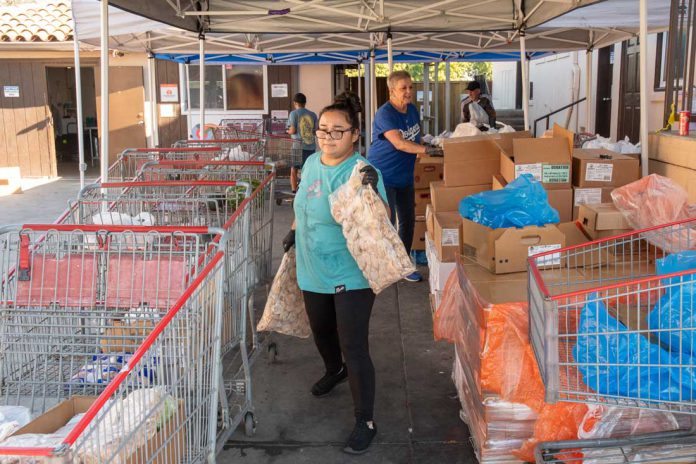
Food pantries across South County are experiencing unprecedented demand following the suspension of SNAP benefits due to the federal government shutdown, with lines wrapping around blocks and new families seeking assistance at rates not seen since the COVID-19 pandemic.
The Reach Out Food Pantry in Morgan Hill has seen its daily client numbers double in recent weeks, while South County Community Services in Gilroy reports serving nearly 400 more families per week than before the shutdown.
Formerly known as Saint Joseph’s Family Center, South County Community Services is experiencing unprecedented demand and long lines that persist for hours. The number of families receiving assistance has increased by 25% since August, serving almost 7,500 families in October.
“With the CalFresh shutdown setbacks, the need has increased immensely in the last couple of weeks, it has just skyrocketed,” said Vicky Martin, community engagement director at South County Community Services.
Martin, who has worked with the agency for 23 years, said current conditions represent the worst funding environment she has witnessed.
“Unfortunately this is the worst year I have ever witnessed as far as funding for the supportive food industry, as well as resources available to support families in need,” Martin said. “We are serving more than even in COVID times, even more than at the height of need, and we are utilizing far less resources. More families are coming in and receiving less and less, unfortunately.”
Carol Lillig, co-director of the Reach Out Food Pantry, said, “We had double the amount of households we normally serve every day last week. I think normally we might have one or two new households register with us every day, and I think our average last week was about five or six per day, which is pretty significant for us.”
The suspension of federal funding for CalFresh, California’s implementation of the federal Supplemental Nutrition Assistance Program—commonly referred to as food stamps—has forced families who previously relied on monthly benefits ranging from $20 to $300 to seek emergency food assistance.
“A lot of the new people who come in mention that is why they are there, or why they are coming back after a long time,” Lillig said, referring to the suspended SNAP benefits. “Some people get as little as $20 or $30, but other people get closer to $200-300, and those are the people who I think are really stressed out and scrambling.”
The timing compounds normal seasonal pressures on food banks, creating what Lillig describes as a “perfect storm.” November through January typically represents the busiest period for pantries due to holidays, colder weather and children being out of school.
In Gilroy, lines at South County Community Services now wrap around the entire block from the agency’s location on Church Street to First Street and all the way to Monterey Road. The organization operates drive-thru food distribution Tuesdays and Thursdays from 8am-2:30pm or until supplies run out.
Both organizations rely heavily on volunteer support. The Reach Out Food Pantry operates entirely with volunteers, with approximately 150 people involved maintaining daily operations including grocery pickups from local stores, stocking shelves and serving clients during the pantry’s Monday through Saturday hours from 1-2:30pm.
The community response has been generous. Lillig said she receives about five calls daily from concerned residents asking how they can help.
“The most common call is, ‘I am concerned, and feel like I can’t do anything about this government shutdown. Do you need money, or would you rather have food donations?’” Lillig said.
The outpouring of support from individuals has not been enough to keep pace with a lack of funding from grants and reduced donations from businesses, however.
“This is the first year there is no funding whatsoever for food resources, from any kind of grant opportunities,” Martin said. “Sometimes money for food support is heightened, and sometimes it takes a little less of a forward focus. This is the first year where it has been given zero importance.”
Pantry directors warn that sustained demand without restored federal benefits could exhaust resources.
“If this drags on through November, December, January? I’m not quite so sure about that,” Lillig said.
The loss of CalFresh benefits creates cascading financial pressures for families. Lillig, who also works with St. Vincent de Paul ministry helping families pay rent and utilities, said the ministry typically advises clients to take advantage of food assistance programs to preserve their income for housing costs.
“But now, if they lose that SNAP benefit, it just makes it even harder to do that,” she said. “We’re concerned that we’re going to be getting more requests for rent and utilities help as well for folks who are having to spend more of their own income on groceries in addition to going to the pantries.”
Despite community generosity, Martin noted that reduced business inventories have decreased surplus food donations just as demand has surged.
“Because money is so tight right now for businesses, individuals, everyone—businesses are not purchasing as much, and therefore not donating as much surplus,” she said. “The inventory is low, and so it is not coming to food banks, what’s leftover.”
As the financial stress of the shutdown compounds on everyone, creating greater need among the poorest members of the community, it also suppresses others’ ability to donate to charities like Reach Out and South County Community Services, creating a vicious feedback loop that closes tighter and tighter around those with the greatest need.
“We do the best we can when we see a need pop up all of the sudden,” Martin said. “We try to increase our volunteer corps, and we try to dedicate more time into preparing, but we can only be stretched so thin. We’re not sure how far we can be stretched.”














